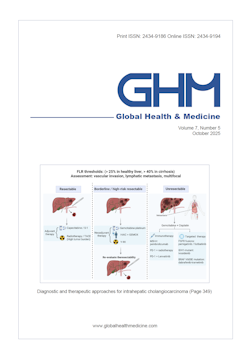Global Health & Medicine 2023;5(1):40-46.
Comparative analysis of the outcomes of gastrectomy vs. endoscopic mucosal resection or endoscopic submucosal dissection for the treatment of gastric tube cancer after esophagectomy
Toyoshima Y, Narumiya K, Kudo K, Egawa H, Hosoda K
This study investigated the clinical characteristics of patients with gastric tube cancer following esophagectomy at our hospital, and to examine the outcomes of gastrectomy versus endoscopic submucosal dissection. Of 49 patients who underwent treatment for gastric tube cancer that developed 1 year or more after esophagectomy, 30 patients underwent subsequent gastrectomy (Group A), and 19 patients underwent endoscopic mucosal resection (EMR) or endoscopic submucosal dissection (ESD) (Group B). The characteristics and outcomes of these two groups were compared. The interval between esophagectomy and diagnosis of gastric tube cancer ranged from 1 to 30 years. The most common location was the lesser curvature of the lower gastric tube. When the cancer was detected early, EMR or ESD was performed, and the cancer did not recur. In advanced tumors, gastrectomy was performed but the gastric tube was difficult to approach and lymph node dissection was difficult; two patients died as a result of the gastrectomy. In Group A, recurrence occurred most often as axillary lymph node, bone, or liver metastases; in Group B, no recurrence or metastases were observed. In addition to recurrence and metastasis, gastric tube cancer is often observed after esophagectomy. The present findings highlight the importance of early detection of gastric tube cancer after esophagectomy and that the EMR and ESD procedures are safe and have significantly fewer complications compared with gastrectomy. Follow-up examinations should be scheduled with consideration given to the most frequent sites of gastric tube cancer occurrence and the time elapsed since esophagectomy.
DOI: 10.35772/ghm.2022.01059







